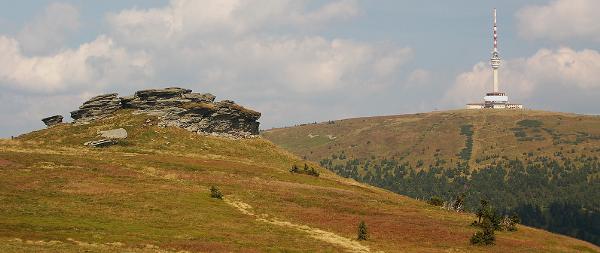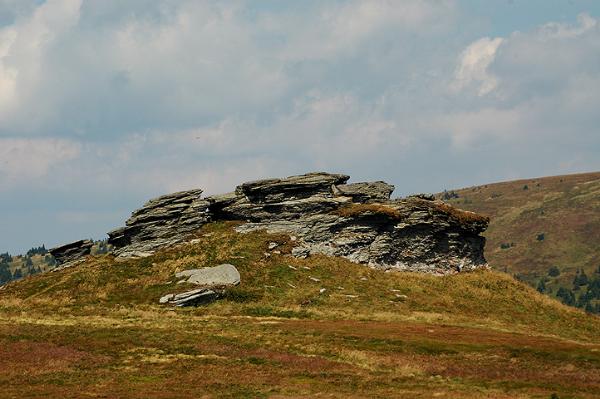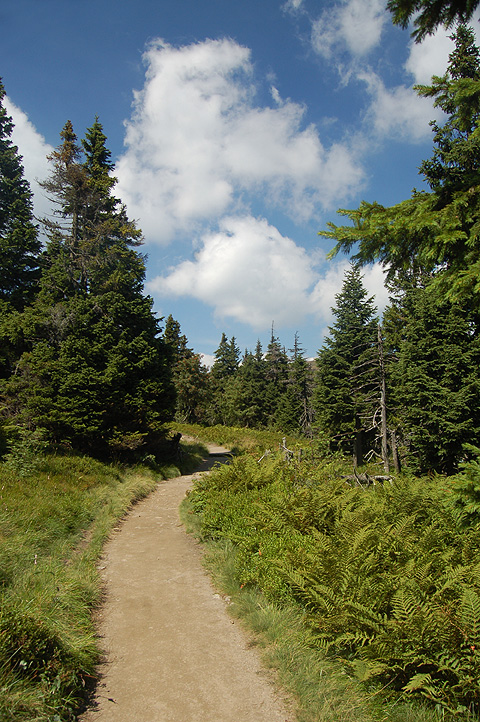Petrovy kameny/Peter's Stones EarthCache
Petrovy kameny/Peter's Stones
-
Difficulty:
-

-
Terrain:
-

Size:  (not chosen)
(not chosen)
Please note Use of geocaching.com services is subject to the terms and conditions
in our disclaimer.
EarthCache venovaná Petrovým kamenum,
prírodní památce blízko Pradedu.
EarthCache devoted to Peter’s Stones, natural landmark next
to Praded.

[CZ] Prosíme, nechodte až k samotným
Petrovým kamenum, zustante na turistické stezce
– ohranicená louka kolem je místem
výskytu nekolika vzácných biotopu, a proto je
také chránena. Jakékoliv
porušení zákazu vstupu na
chránené území muže být
„odmeneno“ pokutou a z naší strany
smazáním logu.
Nad horizont masívu Vysoké hole
vycnívají skalní trosky
nekdejších vrcholových partií –
tzv. Petrovy kameny. Jedná se o výchozy bridlic,
silne rozrušené mrazovou cinností (tzv.
mrazové sruby). Tyto útvary, jejichž rozmery
typicky dosahují 100 metru, vznikají
opakovaným pronikáním vody do skalních
puklin a trhlin. Po poklesu teploty pod bod mrazu tato voda zmrzne
na led, který má vetší objem než
puvodní kapalná fáze, címž
dochází k rozrušení horniny
„zevnitr“, tzv. mrazovému
tríštení. Reliktem po dobe ledové,
která místo zasáhla v pleistocénu, jsou
také zdejší mrazem trídené
polygonální pudy.
 Oblast kolem
Petrových kamenu je soucástí
Národní prírodní rezervace Praded. Po
skoncení dob ledových našly v tomto prostoru
úkryt rostliny a živocichové, které jinak
mužete najít až daleko na severu ve
Skandinávii. Podnebí jiných
cástí Jeseníku pro ne bylo
príliš teplé. Jiné dokonce jinde na
svete nenajdete – k nim patrí drobný zvonek
jesenický a nízká skalní tráva
lipnice jesenická. Mimo to se zde pravidelne
vyskytují i dva velmi vzácné druhy brouku
– drobný hnojník a vyklenulec –
kterí jsou pozustatky doby ledové a nebyli nikde
jinde na Morave nalezeny.
Oblast kolem
Petrových kamenu je soucástí
Národní prírodní rezervace Praded. Po
skoncení dob ledových našly v tomto prostoru
úkryt rostliny a živocichové, které jinak
mužete najít až daleko na severu ve
Skandinávii. Podnebí jiných
cástí Jeseníku pro ne bylo
príliš teplé. Jiné dokonce jinde na
svete nenajdete – k nim patrí drobný zvonek
jesenický a nízká skalní tráva
lipnice jesenická. Mimo to se zde pravidelne
vyskytují i dva velmi vzácné druhy brouku
– drobný hnojník a vyklenulec –
kterí jsou pozustatky doby ledové a nebyli nikde
jinde na Morave nalezeny.
Proc se Petrovy kameny jmenují práve Petrovy, se
neví – jedna z místních povestí
ale ríká, že zde kdysi žil kovár
jménem Petr, do kterého se zamilovala dcera
správce sovineckého panství. Její otec
lásce neprál, a když domlouvání
dceri nepomáhalo, rozhodl se Petra nechat uveznit. Jeho
dcera se ale o techto plánech dozvedela a o jedné
temné noci se svým milým tajne uprchla. V
zápetí se však po jejich stopách vydali
pronásledovatelé a oba milenci, kterí cestu do
hor neznali, byli brzy se silami na konci. V tu chvíli se
ale zvednul vítr a zacala hrozivá boure – oba
se tedy schovali vysíleni do vresu u skály na
Vysoké holi, kde necas preckali. Když se vycasilo,
nebylo po pronásledovatelích ani slechu, v tom necase
dvojici minuly a dolu na panství se vrátili s
neporízenou. Petr a jeho milá pak pokracovali v ceste
a ráno již byli za hranicemi panství, kde se
usadili a štastne žili až do smrti.
Skály Petrových kamenu sehrály
ústrední roli v carodejnických procesech,
které se konaly v nedalekých Velkých
Losinách na sklonku 17. století. Údajne se zde
o Filipojakubské noci mely slétat carodejnice, aby na
tomto pustém míste pripravovaly svá kouzla a
cáry na celý další rok. Hlavní
slovo v techto procesech mel laický soudce Jindrich Boblig z
Edelstadtu, který ruznými metodami výslechu
vcetne mucení vynutil priznání k
carodejnictví z mnoha nevinných dívek a
žen, které byly posléze upáleny na
hranici. Zrejme nejznámejší obetí
techto procesu se pak stal roku 1685 šumperský dekan
Kryštof Alois Lautner, který vystoupil na obranu
domnelých carodejnic – tomu je venována
mohelnická cache
Kryštof Alois Lautner.
Vaše úkoly:
1) k logu priložte svou fotku z výše
uvedených souradnic s GPSkou v ruce a s Petrovými
kameny viditelnými v pozadí (z tohoto duvodu
prosím zvažte pocasí, za jakého
vyrazíte, fotografie postavy v mlze s GPSkou nelze
brát jako dukaz, že jste místo
navštívili :)
2) na email tinah.power.team@email.cz nám
zašlete co nejlepší odhad rozmeru
Petrových kamenu (AxBxC metru). Aby to ale nebylo tak
jednoduché, nestací jen hádat – tj.
napsat nám nejaká císla – k
uznání logu nám budete muset (alespon ve
zkratce) popsat metodu, jak jste k temto císlum došli
(protože je nejbližší okolí
Petrových kamenu nedostupné, využijte
prosím nekterou z metod dálkového pruzkumu
popsaných níže).
 Metody
dálkového pruzkumu
Metody
dálkového pruzkumu
Pokud se pruzkumník nemuže dostat k nejakému
geografickému útvaru nebo je onen útvar
príliš rozlehlý, mohou být k
presnému promerení s úspechem využity
metody dálkového pruzkumu.
Nejjednodušší takovou metodou je
analýza fotografií dotycného útvaru,
které ale musí být správne
zkalibrovány – preloženo do obecného
jazyka to znamená, že si nekdo dal tu práci a
presne urcil, co ukazují (napr. jestli barvy
odpovídají realite, jaké je
rozlišení fotografií atd.). Cesko je
naštestí pokryto relativne detailními
leteckými fotomapami, takže zjistit
horizontální rozmery jakéhokoliv
geologického útvaru vám bude trvat s
použitím trojclenky a pravítka jen chvilku.
Trochu komplikovanejší už bude
zjištení vertikálního rozmeru – k
tomu mužete s úspechem použít
vlastní fotografii „z boku“, kde budete moci
urcit pomer délky a výšky. Pokud ale budete
chtít využít jakoukoliv jinou metodu,
vaší invenci se meze nekladou.
[EN] Please, do not walk directly to Peter’s Stones;
stay on the tourist trail – the meadows surrounding them are
home of several rare species and therefore are protected by law.
Any violation of the entry prohibition into this protected area may
be "rewarded" by a fine and by deletion of your log by us.
Above the horizon of Vysoká Hole rock debris of the former
top parts stand out – the so-called Peter's Stones. These are
shale outcrops, heavily eroded by frost (so-called frost cribs).
These units, whose dimensions typically reach 100 meters, were
formed by repeated infiltration of water into rock fissures and
cracks. When the temperature drops below freezing the water freezes
into ice, which has a larger volume than its original liquid state.
This leads to destruction of rock from "inside", so called frost
fragmentation. Relics of the Ice Age, which hit this area in the
Pleistocene, are also local frost sorted polygonal soils.
 The area surrounding
Peter's Stones is a part of the National Nature Reservation Praded.
When the Ice Age was over, plants and animals, which otherwise can
be found only to the far north of Scandinavia, found home in this
place. Climate of other parts of Jeseníky was too warm for
them. Other species cannot be even found elsewhere in the world
– among them a small Campanula gelida and low rocky meadow
grass Poa riphaea. In addition, there are regularly registered two
very rare species of beetles here – small Aphodiidae and
Byrrhus pilula - which are the remains of the Ice Age and have not
been found elsewhere in Moravia.
The area surrounding
Peter's Stones is a part of the National Nature Reservation Praded.
When the Ice Age was over, plants and animals, which otherwise can
be found only to the far north of Scandinavia, found home in this
place. Climate of other parts of Jeseníky was too warm for
them. Other species cannot be even found elsewhere in the world
– among them a small Campanula gelida and low rocky meadow
grass Poa riphaea. In addition, there are regularly registered two
very rare species of beetles here – small Aphodiidae and
Byrrhus pilula - which are the remains of the Ice Age and have not
been found elsewhere in Moravia.
Why are Peter’s Stones called “Peter’s” is
unclear - one of the local legend says that in this region once
lived a blacksmith named Peter, who had fallen in love with the
daughter of an administrator of the Sovinec estate. Her father did
not agree with this love, and when his daughter refused to end it,
he decided to put Peter in jail. His daughter, however, became
aware of these plans, and one dark night she secretly fled with her
lover. But in a short moment after their trail went pursuers and
the two lovers who did not know how to travel in the mountains were
soon at the end of their forces. At that moment, a strong wind
started and a threatening storm began – both lovers therefore
hid in the rocks on the heath of Vysoká Hole, where they
survived the foul weather. When the sky turned clear again the
pursuers had passed them, and as they kept going they returned back
empty handed. Peter and his love continued in the way and in the
morning they reached border of the estate, where they settled and
lived happily ever after.
Rocks in Peter's Stones played a central role in the witch trials
that took place in the nearby Velké Losiny at the late 17th
century. Reportedly this lonely place was a gathering point of
witches from nearby area during the Walpurgis Night (Beltane) where
they prepared their magic and spells for the next year. The main
word in these processes has a secular judge Heinrich Boblig von
Edelstadt who – using various interrogation techniques,
including torture – forced many innocent girls and women
suspected from witchcraft to confession ending their lives by being
burned at the stake. Probably the most known victim of these
processes became in 1685 Šumperk’s dean Kryštof
Alois Lautner, who spoke in defense of alleged witches – to
his memory it is dedicated Mohelnice’s cache
Kryštof Alois Lautner.
Your tasks:
1) to your log add a photo of you with your GPS made at the
above-mentioned coordinates and Peter‘s Stones visible in the
background (because of this reason please consider the weather
forecast for the estimated time you will be at the place, photos of
a figure with GPS standing in the mist will not be accepted as
evidence that you have visited the place :)
2) send us an email to tinah.power.team@email.cz with your
best estimate of Peter's Stones’ dimensions (AxBxC meters).
To make it a bit more difficult, you cannot just guess – i.e.
just to write us some numbers – your log will be accepted
only then, if you can (at least in brief) describe in the email the
method of how you came to these numbers (since the nearest
surroundings of Peter's Stones are unavailable, please use some of
the remote-sensing techniques described below).
 Methods of remote
sensing
Methods of remote
sensing
If an explorer cannot get to some geographical unit or this unit is
too large, then any measurement of this feature can be in principle
done using remote sensing methods. The simplest such method is the
analysis of photographs of the body, but these must be properly
calibrated – translated into the common language, this means
that someone spends his time to determine exactly what they show
(e.g., if the colors correspond to reality, what is the resolution
of photographs, etc.). Fortunately, Czechia is covered by a pretty
good airborne imagery, so to determine the horizontal dimensions of
any geological unit you will need just to employ the golden rule
and a ruler. Little more complicated will be finding of a vertical
dimension – here you can successfully use your own
“side-photos", from which you will be able to determine the
ratio of length and height. But if you want to use any other
method, we will of course not restrict your invention in any way.
Additional Hints
(No hints available.)